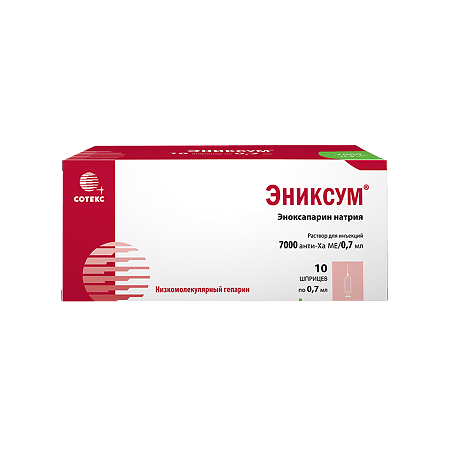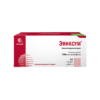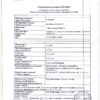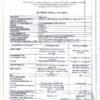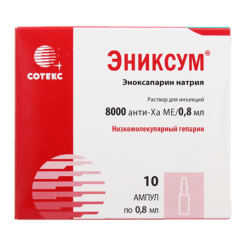No products in the cart.
Enixum 7000 anti-Ha IU/0.7 ml 0.7 ml, syringes 10 pcs.
€1.00
Out of stock
(E-mail when Stock is available)
Description
Enoxaparies sodium is a low molecular weight heparin. The average molecular weight is about 4500 daltons: less than 2000 daltons – < 20%, from 2000 to 8000 daltons – > 68%, more than 8000 daltons – < 18%. Enoxaparies sodium is obtained by alkaline hydrolysis of heparin benzine ester isolated from the mucous membrane of pig small intestine. Its structure is characterized by a nonreducible fragment of 2-0-sulfo-4-enpyrazinosuronic acid and a reducible fragment of 2-14.6-0-disulfo-0-glucopyranoside.
The structure of enoxaparin sodium contains about 20% (ranging from 15% to 25%) of the 1.6- anhydron derivative in the reducing fragment of the polysaccharide chain.
Pharmacodynamics
In vitro enoxaparyl sodium has high activity against factor Ha clotting (anti-Xa activity approximately 100 IU/ml) and low activity against factor Na clotting (antp IIa or anti-thrombin activity approximately 28 IU/ml). This anticoagulant activity is mediated by antithrombin III (AT-III). In addition to anti-Xa/IIa activity, additional anticoagulant and anti-inflammatory properties of enoxaparpene sodium have also been identified in both human and animal models, which include AT-III-dependent inhibition of other clotting factors such as factor Vila, activation of tissue factor pathway inhibitor release, and reduction of Willebrand factor release from the vascular endothelium into the bloodstream. These factors provide the anticoagulant effect of enoxaparin sodium in general.
When used in prophylactic doses, sodium epoxaparin slightly changes the activated partial thromboplastin time (APT). It has almost no effect on platelet aggregation and on the degree of binding of fibrinogen to platelet receptors.
The anti-IIa activity in plasma is about 10 times lower than the anti-Xa activity.
The mean maximum anti-IIa activity is observed about 3-4 h after subcutaneous administration and reaches 0.13 IU/ml and 0.19 IU/ml after repeated administration of 1 mg/kg body weight – when administered twice and 1.5 mg/kg body weight – when administered once, respectively. Mean maximum plasma anti-Xa activity is observed 3-5 h after subcutaneous administration of the drug and is approximately 0.2; 0.4; 1.0 and 1.3 anti-Xa IU/ml after subcutaneous administration of 20 mg, 40 mg and 1 mg/kg and 1.5 mg/kg, respectively
.
Indications
Indications
– prevention of venous thrombosis and embolism during surgical interventions, especially during orthopedic and general surgical operations;
– prevention of venous thrombosis and embolism in patients on bed rest due to acute therapeutic diseases (including acute heart failure and decompensation of chronic heart failure (NYHA class III or IV), acute respiratory failure; acute infectious diseases; acute stages of rheumatic diseases in combination with one of the risk factors for venous thrombus formation (see “Special Instructions”));
– treatment of deep vein thrombosis, which is accompanied or not accompanied by pulmonary embolism;
– treatment of unstable angina and myocardial infarction without a Q wave in combination with acetylsalicylic acid;
– prevention of thrombus formation in the extracorporeal circulatory system during hemodialysis (usually with a session duration of no more than 4 hours);
– treatment of acute ST-segment elevation myocardial infarction in patients undergoing medical treatment or subsequent percutaneous coronary intervention.
Pharmacological effect
Pharmacological effect
Enoxaparium sodium – low molecular weight heparin. Average molecular weight is about 4500 daltons: less than 2000 daltons – 68%, more than 8000 daltons – <18%. Sodium enoxaparium is obtained by alkaline hydrolysis of heparin benzene ester isolated from the mucous membrane of the small intestine of pigs. Its structure is characterized by a non-reducing 2-0-sulfo-4-enpyrazinosuronic acid moiety and a reducing 2-14.6-0-disulfo-0-glucopyranoside moiety.
The structure of enoxaparin sodium contains about 20% (ranging from 15% to 25%) 1,6-anhydrone derivative in the reducing fragment of the polysaccharide chain.
Pharmacodynamics
In vitro, enoxaparium sodium has high activity against coagulation factor Xa (anti-Xa activity approximately 100 IU/ml) and low activity against coagulation factor B (anti-Xa activity approximately 28 IU/ml). This anticoagulant activity is mediated by antithrombin III (AT-III). In addition to anti-Xa/IIa activity, additional anticoagulant and anti-inflammatory properties of enoxaparpne sodium have also been identified, both in humans and in animal models, which include AT-III-dependent inhibition of other coagulation factors such as factor Vila, activation of the release of tissue factor pathway inhibitor, and a decrease in the release of von Willebrand factor from the vascular endothelium into the bloodstream. These factors provide the anticoagulant effect of enoxaparin sodium in general.
When used in prophylactic doses, epoxaparin sodium slightly changes the activated partial thromboplasty typical time (aPTT). has virtually no effect on platelet aggregation and the degree of binding of fibrinogen to platelet receptors.
Anti-IIa activity in plasma is approximately 10 times lower than anti-Xa activity.
The average maximum anti-IIa activity is observed approximately 3-4 hours after subcutaneous administration and reaches 0.13 IU/ml and 0.19 IU/ml after repeated administration of 1 mg/kg body weight – with a double dose and 1.5 mg/kg body weight – with a single dose, respectively. The average maximum anti-Xa activity of plasma is observed 3-5 hours after subcutaneous administration of the drug and is approximately 0.2; 0.4; 1.0 and 1.3 anti-Xa IU/ml after subcutaneous administration of 20 mg, 40 mg and 1 mg/kg and 1.5 mg/kg, respectively
Special instructions
Special instructions
General
Low molecular weight heparins are not interchangeable, as they differ in the manufacturing process, molecular weight, specific anti-Xa activity, dosage units and dosage regimen, which are associated with differences in their pharmacokinetics and biological activity (antithrombin activity and interaction with platelets). It is necessary to strictly follow the recommendations for the use of each drug belonging to the class of low molecular weight heparins.
Bleeding
As with the use of other anticoagulants, when using the drug Enixum®, bleeding of any location may develop (see “Side effects”). If bleeding develops, it is necessary to find its source and prescribe appropriate treatment.
Bleeding in elderly patients
When using enoxaparin sodium in prophylactic doses in elderly patients, there was no tendency to increase bleeding. When using enoxaparin sodium in therapeutic doses in elderly patients (especially those aged 80 years and older), there is an increased risk of bleeding. It is recommended to carefully monitor the condition of such patients (see “Pharmacokinetics” and “Dosage and Administration”, subsection “Elderly Patients”). Simultaneous use of no other drugs that affect hemostasis is recommended. so that the use of drugs affecting hemostasis (salicylates, including acetylsalicylic acid, NSAIDs, including ketorolac, dextrin with a molecular weight of 40 kDa, ticlopidine, clopidogrel, corticosteroids, thrombolytics, anticoagulants, antiplatelet agents, including antagonists of glycoprotein IIb/IIIa reviewers) is discontinued before starting treatment enoxaparin sodium, except when their use is necessary. If combinations of enoxaparin sodium with these drugs are indicated, careful clinical observation and monitoring of relevant laboratory parameters should be carried out.
Kidney failure
In patients with impaired renal function, there is a risk of bleeding due to increased systemic exposure to enoxaparin sodium
In patients with severe renal impairment (creatinine clearance less than 30 ml/min), there is a significant increase in exposure to enoxaparin sodium, so dose adjustment is recommended. both for prophylactic and therapeutic use of the drug. Although no dose adjustment is required in patients with mild to moderate renal impairment (creatinine clearance 30-50 ml/min or 50-80 ml/min), careful monitoring of the condition of such patients is recommended (see Pharmacokinetics and Dosage and Administration, subsection “Patients with Renal Impairment”).
Low body weight
There was an increase in exposure to enoxaparin sodium when used prophylactically in women weighing less than 45 kg and in men weighing less than 57 kg. which may lead to an increased risk of bleeding. Careful monitoring of the condition of such patients is recommended.
Obese patients
Obese patients have an increased risk of developing thrombosis and embolism. The safety and effectiveness of the use of enoxaparin sodium in prophylactic doses in obese patients (body mass index more than 30 kg/m2) has not been fully determined, and there is no general consensus on dose adjustment. These patients should be closely monitored for the development of symptoms and signs of thrombosis and embolism.
Monitoring the number of platelets in peripheral blood
The risk of developing antibody-mediated heparin-inducing thrombocytopenia also exists with the use of low molecular weight genarins. If thrombosis develops, it is usually detected between the 5th and 21st days after the start of therapy with enoxaparin sodium. In this regard, it is recommended to regularly monitor the platelet count in peripheral blood before starting treatment with Enixum® and during its use. If there is a confirmed significant decrease in platelet count (by 30-50% compared to the initial value), it is necessary to immediately discontinue enoxaparin sodium and transfer the patient to another therapy. Spinal/epidural anesthesia
Cases of neuraxial hematomas have been described when using enoxaparin sodium with simultaneous spinal/epidural anesthesia with the development of long-term or irreversible paralysis. The risk of these events is reduced when using enoxaparin sodium at a dose of 40 mg or lower.
The risk increases with the use of higher doses of enoxaparin sodium, as well as with the use of indwelling catheters after surgery or with the simultaneous use of additional drugs that affect hemostasis, such as NSAIDs (see “Interactions”). The risk also increases with traumatic or repeated spinal puncture or in patients with a history of spinal surgery or spinal deformity. To reduce the possible risk of bleeding associated with the use of enoxaparin sodium and epidural or spinal anesthesia/analgesia. it is necessary to take into account the pharmacokinetic profile of the drug (see “Pharmacokinetics”). Catheter insertion or removal is best done when the anticoagulant effect of enoxanarine sodium is low, but the exact time to achieve sufficient reduction in anticoagulant effect in different patients is unknown.
Insertion or removal of the catheter should be carried out at least 12 hours after administration of lower doses of Enixum® (20 mg once daily, 30 mg once or twice daily, 40 mg once daily) and at least 24 hours after administration of higher doses of Enixum® (0.75 mg/kg body weight twice daily, 1 mg/kg body weight twice daily, 1.5 mg/kg once daily). day). At these time points, the anti-Xa activity of enoxanarine sodium is still detectable, and time delays are not a guarantee of this. that the development of a neuraxial hematoma can be avoided.
Patients receiving enoxaparin sodium at doses of 0.75 mg/kg body weight twice daily or 1 mg/kg body weight twice daily, with this (twice daily) dosing regimen, should not administer a second dose in order to increase the interval before inserting or replacing the catheter. Similarly, the possibility of delaying the next dose of enokeaparin sodium for at least 4 hours should be considered based on an assessment of the benefit/risk ratio (risk of thrombosis and bleeding during the procedure, taking into account the presence of risk factors in patients). However, it is not possible to give clear recommendations on the timing of the next dose of enokeaparin sodium after catheter removal. It should be taken into account that in patients with creatinine clearance less than 30 ml/min, the elimination of enoceaparin sodium is slowed down. Therefore, in this category of patients, doubling the time from catheter removal should be considered: at least 24 hours for lower doses of enoxaparin sodium (30 mg once daily) and at least 48 hours for higher doses (1 mg/kg body weight per day).
If anticoagulant therapy is used as prescribed by a physician during epidural/spinal anesthesia or lumbar puncture, constant monitoring of the patient is necessary to identify any neurological symptoms, such as pain in the blue, impaired sensory and motor function (numbness or weakness in the lower extremities), impaired bowel and/or bladder function. The patient should be instructed to immediately inform the doctor if the above symptoms occur. If symptoms characteristic of a spinal cord hematoma are suspected, prompt diagnosis and treatment are necessary, including, if necessary, spinal cord decompression.
Heparin-induced thrombocytopenia
Enixum® should be used with extreme caution in patients with a history of heparin-induced thrombocytonepia with or without thrombosis.
The risk of developing heparin-induced thrombocytopenia may persist for several years. If the history suggests the presence of heparin-induced thrombocytopenia, then in vitro platelet aggregation tests are of limited value in predicting the risk of its development. The decision to use Enixum in this case can only be made after consultation with an appropriate specialist.
Percutaneous coronary angioplasty
To minimize the risk of bleeding associated with invasive vascular instrumentation in the treatment of unstable angina and non-Q wave myocardial infarction and acute ST-segment elevation myocardial infarction. these procedures should be carried out in the intervals between administration of the drug Enixum. This is necessary in order to achieve hemostat after percutaneous coronary intervention. If a closure device is used, the femoral artery sheath can be removed immediately. If manual compression is used, the femoral artery sheath should be removed 6 hours after the last intravenous or subcutaneous injection of znoxaparin sodium. If treatment with epoxaparin sodium is continued, the next dose should be administered no earlier than 6-8 hours after removal of the femoral artery sheath. It is necessary to monitor the insertion site of the introducer. to promptly identify signs of bleeding and hematoma formation.
Patients with mechanical prosthetic heart valves The use of enoxaparin sodium for the prevention of thrombus formation in patients with mechanical prosthetic heart valves has not been sufficiently studied. There are isolated reports of the development of heart valve thrombosis in patients with mechanical artificial heart valves during therapy with epoxaparin sodium for the prevention of thrombus formation. The evaluation of these reports is limited by the presence of competing factors that contribute to the development of thrombosis of prosthetic heart valves, including the underlying disease, and by the paucity of clinical data. Variables in women with mechanical prosthetic heart valves The use of eioxaparin sodium for the prevention of thrombus formation in pregnant women with mechanical prosthetic heart valves has not been well studied. In a clinical study of pregnant women with mechanical prosthetic heart valves using enoxaparin sodium at a dose of 1 mg/kg twice daily to reduce the risk of thrombosis and embolism, 2 out of 8 women developed a blood clot, leading to blockage of the heart valves and death of the mother and fetus.
There have been isolated post-marketing reports of valvular thrombosis in pregnant women with mechanical prosthetic heart valves treated with enoxaparin sodium for thrombotic prophylaxis. Pregnant women with mechanical artificial heart valves are at high risk of developing thrombosis and embolism. Laboratory tests
At doses used for the prevention of thromboembolic complications, enoxaparin sodium does not significantly affect bleeding time and blood coagulation parameters, as well as platelet aggregation or their binding to fibrinogen.
As the dose increases, the aPTT and activated clotting time may prolong. The increase in aPTT and activated clotting time are not in a direct linear relationship with the increase in the anticoagulant activity of the drug, so there is no need to monitor them.
Prevention of venous thrombosis and embolism in patients with acute therapeutic diseases who are on bed rest
In the event of the development of an acute infection or acute rheumatic conditions, the prophylactic use of enoxaparin sodium is justified only if the above conditions are combined with one of the following risk factors for venous thrombus formation: age over 75 years; malignant neoplasms: history of thrombosis and embolism; obesity; hormone therapy; heart failure; chronic respiratory failure.
Impact on the ability to drive vehicles. Wed and fur.:
There is no data indicating a negative effect of enoxaparin sodium on the ability to drive vehicles and engage in other potentially hazardous activities that require increased concentration and speed of psychomotor reactions.
Active ingredient
Active ingredient
Enoxaparin sodium
Composition
Composition
1 syringe (0.7 ml) contains
as an active substance
Contraindications
Contraindications
– Hypersensitivity to enoxaparin sodium, heparin or its derivatives, including other low molecular weight heparins;
– active major bleeding, as well as conditions and diseases in which there is a high risk of bleeding: threatened abortion, cerebral aneurysm or dissecting aortic aneurysm (except in cases of surgical intervention for this reason). recent hemorrhagic stroke, uncontrolled bleeding, thrombocytopenia in combination with a positive in vitro test for antiplatelet antibodies in the presence of enoxaparin sodium;
– the use of sodium eoxaparin for the prevention of thrombus formation in pregnant women with mechanical artificial heart valves is not recommended (lack of clinical experience with use);
– age under 18 years (efficacy and safety have not been established).
With caution:
Conditions in which there is a potential risk of bleeding:
– hemostasis disorders (including hemophilia, thrombocytopenia, hypocoagulation, von Willebrand disease, etc.), severe vasculitis;
– peptic ulcer of the stomach or duodenum or others;
– history of erosive and ulcerative lesions of the gastrointestinal tract;
– recent ischemic stroke;
– uncontrolled severe arterial hypertension;
– diabetic or hemorrhagic retinopathy;
– severe diabetes mellitus;
– recent or proposed neurological or ophthalmological surgery;
– spinal or epidural anesthesia (potential danger of hematoma development), spinal puncture (recently undergone):
– recent birth;
– bacterial endocarditis (acute or subacute):
– pericarditis or pericardial effusion;
– renal and/or liver failure;
– intrauterine contraception (IUD);
– severe trauma (especially of the central nervous system (CNS)), open wounds on large surfaces;
– simultaneous use of drugs that affect the hemostasis system;
– heparin-induced thrombocytopenia (history) in combination with or without thrombosis.
There are no data on the clinical use of enoxaparin sodium in the following diseases: active tuberculosis, radiation therapy (recently undergone).
Side Effects
Side Effects
Side effects were classified by frequency as follows: very common (> 1/10), common (> 1/100 – 1/1000 – 1/10000 – < 1/1000), very rare (< 1/10000).
Bleeding
Bleeding may occur, especially in the presence of associated risk factors: organic changes with a tendency to bleeding, age, renal failure, low body weight and certain drug combinations (see “Interactions with other drugs”). If bleeding develops, it is necessary to discontinue the drug, establish the cause of the bleeding and begin appropriate therapy.
Very common – bleeding during the prevention of venous thrombosis, in surgical patients and in the treatment of deep vein thrombosis with or without thromboembolism.
Frequent – bleeding during the prevention of venous thrombosis in patients on bed rest and during the treatment of angina pectoris, myocardial infarction without a Q wave and myocardial infarction with ST segment elevation.
Uncommon: Retroperitoneal bleeding and intracranial bleeding in patients treated for deep vein thrombosis with or without thromboembolism, as well as ST-segment elevation myocardial infarction.
Rare – retroperitoneal bleeding in the prevention of venous thrombosis in surgical patients and in the treatment of angina pectoris, myocardial infarction without a Q wave.
When using enoxaparin sodium against the background of spinal/epidural anesthesia and postoperative use of penetrating catheters, rare cases of the formation of neuraxial hematomas have been described, leading to neurological disorders of varying severity, including long-term or irreversible paralysis (see “Special Instructions”).
Thrombocytopenia and platelets
Very common – thrombocytosis in the prevention of venous thrombosis in surgical patients and the treatment of deep vein thrombosis with or without thromboembolism.
Frequent – thrombocytopenia. For the prevention of venous thrombosis in surgical patients and the treatment of deep vein thrombosis with or without thromboembolism, as well as for myocardial infarction with ST segment elevation.
Uncommon – thrombocytopenia in the prevention of venous thrombosis in patients on bed rest and in the treatment of angina pectoris, myocardial infarction without a Q wave.
Very rare – autoimmune thrombocytopenia in myocardial infarction with ST segment elevation.
In rare cases, the development of autoimmune thrombocytopenia in combination with thrombosis has been reported. In some of them, thrombosis was complicated by organ infarction or limb ischemia (see section “Special Instructions”).
Others
Very often – increased activity of “liver” transaminases.
Often – allergic reactions, urticaria, itching, redness of the skin, hematoma and pain at the injection site.
Uncommon: skin (bullous rashes), inflammatory reaction at the injection site, skin necrosis at the injection site.
Rarely – anaphylactic and anaphylactoid reactions, hyperkalemia. Skin necrosis may develop at the injection site, preceded by the appearance of purpura or erythematous painful papules. In these cases, drug therapy should be discontinued. The formation of hard inflammatory nodules-infiltrates at the injection site of the drug is possible, which disappear after a few days and are not grounds for discontinuation of the drug.
Interaction
Interaction
Enixum should not be mixed with other medications in the same syringe.
When used simultaneously with other drugs that affect hemostasis (salicylates, including acetylsalicylic acid, non-steroidal anti-inflammatory drugs (NSAIDs), including ketorolac, dextran with a molecular weight of 40 kDa, ticlopidine, clopidogrel, systemic glucocorticosteroids (GCS), thrombolytics or anticoagulants, others antiplatelet drugs, including antagonists of glycoprotein IIb/IIIa receptors), the risk of bleeding increases (see “Special Instructions”).
Overdose
Overdose
Symptoms: hemorrhagic complications due to accidental overdose with subcutaneous administration of enoxaparin sodium. In case of accidental ingestion of even large doses, absorption of the drug is unlikely.
Treatment: neutralize the effect of enoxaparin sodium by slow intravenous (IV) administration of protamine sulfate. 1 mg of protamine sulfate neutralizes the anticoagulant effect of 1 mg of enoxaparin sodium if the drug was administered no more than 8 hours before the administration of protamine sulfate.
0.5 mg protamine sulfate neutralizes the anticoagulant effect of 1 mg enoxaparin sodium if it was administered more than 8 hours ago or if a second dose of protamine sulfate is necessary.
If 12 or more hours have passed since the administration of enoxaparin sodium, the administration of protamine sulfate is not required. However, even with the introduction of large doses of protamine sulfate, the anti-Xa activity of enoxaparin sodium is not completely neutralized (maximum 60%).
Storage conditions
Storage conditions
At a temperature not exceeding 25 °C. Do not freeze.
Keep out of the reach of children.
Shelf life
Shelf life
2 years. Do not use after the expiration date stated on the package.
Manufacturer
Manufacturer
PharmFirma Sotex, Russia
Additional information
| Shelf life | 2 years. Do not use after the expiration date printed on the package. |
|---|---|
| Conditions of storage | At a temperature not exceeding 25 ° C. Do not freeze. Store out of the reach of children. |
| Manufacturer | PharmFirm Sotex, Russia |
| Medication form | solution for injection |
| Brand | PharmFirm Sotex |
Other forms…
Related products
Buy Enixum 7000 anti-Ha IU/0.7 ml 0.7 ml, syringes 10 pcs. with delivery to USA, UK, Europe and over 120 other countries.

